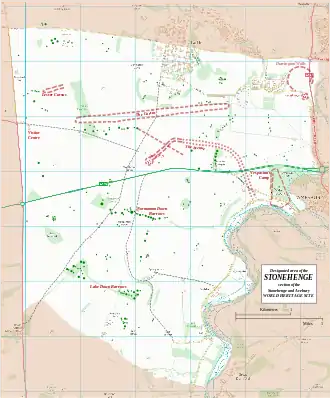Blick Mead
Blick Mead is a chalkland spring in Wiltshire, England, which has a constant temperature of around 11 °C (52 °F) and never freezes. It is close to an Iron Age hill fort known as Vespasian's Camp and about a mile from the Stonehenge ancient monument. Archaeology at the site conducted since 2005 shows human habitation going back to 10,000 BP (8,000 BCE) and to be continuous until 6,000 BP (4,000 BCE).
Map showing Blick Mead within the Stonehenge section of the Stonehenge and Avebury World Heritage Site | |
| Location | OS SU14934204 |
|---|---|
| Region | Wiltshire |
| Coordinates | 51.177001°N 1.788161°W |
| Type | Mesolithic site |
| History | |
| Periods | Mesolithic |
| Site notes | |
| Excavation dates | 2005 onwards |
| Designated | 1986[1] |
| Reference no. | 373 |
35,000 worked flints and 2400 animal bones, some cooked, mostly from Aurochsen, have been found at the site.[2] There is also the remains of a pit dwelling. These have been used to radiocarbon date the time of settlement. It is thought that the site would have been an attractive place to camp or dwell with a spring that never freezes over.
A rare algae called Hildenbrandia lives in the spring and it causes stones taken from it to turn bright red on exposure to air in a matter of hours. In Mesolithic times this could have given the place a magical significance. Its closeness to Stonehenge has led to theories that it is the original attraction that brought hunters to the area, with the colour-changing stones giving the place a spiritual significance in their culture.[3][4][5][6]
References
- UNESCO World Heritage site No 373
- Knapton, Sarah (2 November 2019). "Britain's first city discovered as archaeologists say it was home of people who built Stonehenge". The Telegraph. ISSN 0307-1235. Retrieved 4 November 2019.
- "Vespasian's Camp: Cradle of Stonehenge". Current Archaeology. 19 April 2013. Retrieved 16 January 2017.
- "The New Discoveries at Blick Mead: the Key to the Stonehenge Landscape". www.buckingham.ac.uk. University of Buckingham. Retrieved 15 January 2017.
- Professor David Jacques FSA (21 September 2016). "'The Cradle of Stonehenge'? Blick Mead - a Mesolithic Site in the Stonehenge Landscape -Lecture Transcript". www.gresham.ac.uk. Gresham College. Retrieved 15 January 2017.
- StonehengeNews (15 January 2017). "The Blick Mead excavations have transformed the understanding of the Stonehenge landscape". Stonehenge News and Information. Retrieved 15 January 2017.
